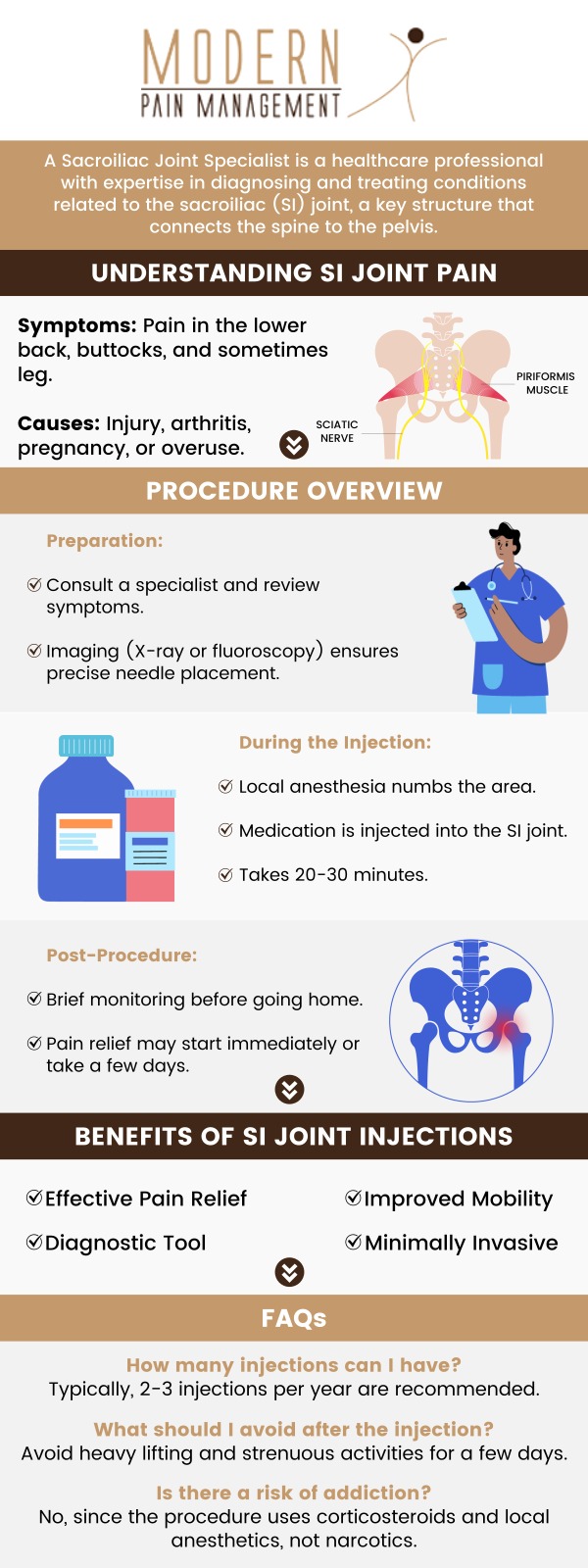What Can a Pain Management Doctor Do for Sacroiliac Joint Pain?
Discover the pathway to relief from sacroiliac joint pain at Modern Pain Management, where Dr. George Atallah, D.O., and our compassionate team are dedicated to providing personalized care and effective solutions. Sacroiliac joint discomfort can significantly impact your daily life, but with our specialized expertise and advanced techniques, we’re here to help you reclaim comfort and mobility. From comprehensive evaluations to tailored treatment plans, we’re committed to addressing the root causes of your pain and empowering you to live life to the fullest. Experience the difference at Modern Pain Management, where your journey to lasting relief begins. For more information, please contact us or book an appointment online. We have convenient locations to serve you in Houston, TX, and Sugar Land, TX.




Table of Contents:
What kind of doctor treats sacroiliac joint pain?
Will my sacroiliac joint pain ever go away?
How is SI joint dysfunction diagnosed?
Is sacroiliac joint pain the same as sacroiliitis?
Sacroiliac joint pain occurs in the joint where the sacrum (the bone at the base of the spine) connects with the ilium (the large pelvic bone) and is essential in maintaining stability and movement within the pelvis. Pain or discomfort within the sacroiliac joint can be the result of several causes, such as sacroiliitis.
Since there are a few potential causes for sacroiliac joint pain, there are a handful of options available for what kind of doctor will be best suited to treat the condition. Patients are encouraged to start by scheduling an appointment with a primary care physician to receive an initial evaluation and assessment of their symptoms and to receive a diagnosis or a referral to a different specialist when applicable. Sacroiliac joint pain can be caused by trauma to the joint causing an injury, or due to an underlying inflammatory condition, so the specialists that may be recommended depending on the displayed symptoms and overall assessment provided by the primary care physician include a rheumatologist, orthopedic surgeon, or physiatrist to ensure that the sacroiliac joint pain is properly managed while the root cause is treated.
If you are suffering from pain localized to your sacroiliac joint, the pain is unlikely to go away without any interventions, but the degree of interventions and treatments required will vary quite a bit depending on the severity and the cause of the pain. Many patients with mild to moderate sacroiliac pain are likely to only experience temporary pain that will eventually go away by only following at-home conservative measures such as properly resting the affected joint and regularly applying hot and cold compresses. More severe cases of sacroiliac joint pain will likely require ongoing management and treatment, often involving physical therapy, nonsteroidal anti-inflammatory medication, and other treatments on top of at-home conservative measures to prevent the pain from worsening.
To accurately diagnose sacroiliac joint dysfunction, healthcare providers will need to take the experienced symptoms, pain levels, medical history, and test results into account. Some of the tests that are used to diagnose SI joint dysfunctions and to rule out other potential causes of SI joint pain include X-rays, MRIs, and CT scans to provide visibility of the joint and surrounding tissues and structures. Diagnostic injections may also be required in some cases to confirm the source of the pain. Your healthcare provider or referred specialist will work with you to determine an accurate diagnosis and treatment plan that is developed based on the diagnostic test results, as well as to treat your specific symptoms. Since SI joint dysfunction can vary so greatly between patients, the treatment plan will take all symptoms as well as the medical history of each patient into account to ensure that they can heal as quickly and efficiently as possible. Every patient suffering from SI joint dysfunction must be able to access the qualified health care that they require to ensure that their condition can heal properly and that any discomfort or pain is managed to prevent unnecessary suffering.
Although sacroiliac joint pain and sacroiliitis are related, they are not the same thing. Sacroiliitis is a condition for which one of the most common symptoms is sacroiliac joint pain and often refers to inflammation that occurs in the sacroiliac joints caused by an underlying health condition such as ankylosing spondylitis or an infection. Sacroiliac joint pain can be a symptom of a variety of conditions or injuries that occur within the sacroiliac joint, including sacroiliitis. Other causes of sacroiliac joint pain include arthritis, an injury to the joint, or muscle imbalances, so this pain can occur without the patient having sacroiliitis. Sacroiliac joint pain simply refers to pain and discomfort that is localized to the sacroiliac joints, whereas sacroiliitis specifically refers to the presence of inflammation within these joints. If you are experiencing pain within the sacroiliac joints, it is recommended that you seek medical attention to accurately determine the cause of the pain, which may result in a diagnosis of sacroiliitis, but may also be due to a variety of other causes.
At Modern Pain Management, we believe that every individual deserves to live a life free from the constraints of chronic pain. With our patient-centered approach and commitment to excellence, we strive to provide not just relief, but long-term solutions that enhance your overall well-being. Dr. George Atallah and our dedicated team are here to support you every step of the way, guiding you toward a future filled with comfort, mobility, and vitality. Take the first step towards a pain-free tomorrow by scheduling your consultation with Modern Pain Management today. For more information, please contact us or book an appointment online. We have convenient locations to serve you in Houston TX and Sugar Land TX. We serve patients from Houston TX, Sugar Land TX, Pearland TX, Jersey Village TX, Missouri City TX, Stafford TX, and Richmond TX.



